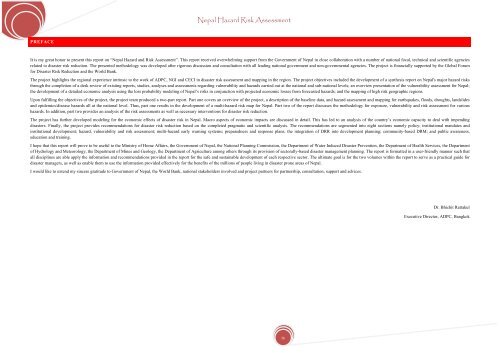Nepal Hazard Risk Assessment - Asia-Pacific Gateway for Disaster ...
Nepal Hazard Risk Assessment - Asia-Pacific Gateway for Disaster ...
Nepal Hazard Risk Assessment - Asia-Pacific Gateway for Disaster ...
You also want an ePaper? Increase the reach of your titles
YUMPU automatically turns print PDFs into web optimized ePapers that Google loves.
<strong>Nepal</strong> <strong>Hazard</strong> <strong>Risk</strong> <strong>Assessment</strong><br />
PREFACE<br />
It is my great honor to present this report on “<strong>Nepal</strong> <strong>Hazard</strong> and <strong>Risk</strong> <strong>Assessment</strong>”. This report received overwhelming support from the Government of <strong>Nepal</strong> in close collaboration with a number of national focal, technical and scientific agencies<br />
related to disaster risk reduction. The presented methodology was developed after rigorous discussion and consultation with all leading national government and non-governmental agencies. The project is financially supported by the Global Forum<br />
<strong>for</strong> <strong>Disaster</strong> <strong>Risk</strong> Reduction and the World Bank.<br />
The project highlights the regional experience intrinsic to the work of ADPC, NGI and CECI in disaster risk assessment and mapping in the region. The project objectives included the development of a synthesis report on <strong>Nepal</strong>'s major hazard risks<br />
through the completion of a desk review of existing reports, studies, analyses and assessments regarding vulnerability and hazards carried out at the national and sub-national levels; an overview presentation of the vulnerability assessment <strong>for</strong> <strong>Nepal</strong>;<br />
the development of a detailed economic analysis using the loss probability modeling of <strong>Nepal</strong>’s risks in conjunction with projected economic losses from <strong>for</strong>ecasted hazards; and the mapping of high risk geographic regions.<br />
Upon fulfilling the objectives of the project, the project team produced a two-part report. Part one covers an overview of the project, a description of the baseline data, and hazard assessment and mapping <strong>for</strong> earthquakes, floods, droughts, landslides<br />
and epidemics/disease hazards all at the national level. Thus, part one results in the development of a multi-hazard risk map <strong>for</strong> <strong>Nepal</strong>. Part two of the report discusses the methodology <strong>for</strong> exposure, vulnerability and risk assessment <strong>for</strong> various<br />
hazards. In addition, part two provides an analysis of the risk assessments as well as necessary interventions <strong>for</strong> disaster risk reduction.<br />
The project has further developed modeling <strong>for</strong> the economic effects of disaster risk in <strong>Nepal</strong>. Macro aspects of economic impacts are discussed in detail. This has led to an analysis of the country’s economic capacity to deal with impending<br />
disasters. Finally, the project provides recommendations <strong>for</strong> disaster risk reduction based on the completed pragmatic and scientific analysis. The recommendations are segmented into eight sections namely policy; institutional mandates and<br />
institutional development; hazard, vulnerability and risk assessment; multi-hazard early warning systems; preparedness and response plans; the integration of DRR into development planning; community-based DRM; and public awareness,<br />
education and training.<br />
I hope that this report will prove to be useful to the Ministry of Home Affairs, the Government of <strong>Nepal</strong>, the National Planning Commission, the Department of Water Induced <strong>Disaster</strong> Prevention, the Department of Health Services, the Department<br />
of Hydrology and Meteorology, the Department of Mines and Geology, the Department of Agriculture among others through its provision of sectorally-based disaster management planning. The report is <strong>for</strong>matted in a user-friendly manner such that<br />
all disciplines are able apply the in<strong>for</strong>mation and recommendations provided in the report <strong>for</strong> the safe and sustainable development of each respective sector. The ultimate goal is <strong>for</strong> the two volumes within the report to serve as a practical guide <strong>for</strong><br />
disaster managers, as well as enable them to use the in<strong>for</strong>mation provided effectively <strong>for</strong> the benefits of the millions of people living in disaster prone areas of <strong>Nepal</strong>.<br />
I would like to extend my sincere gratitude to Government of <strong>Nepal</strong>, the World Bank, national stakeholders involved and project partners <strong>for</strong> partnership, consultation, support and advices.<br />
Dr. Bhichit Rattakul<br />
Executive Director, ADPC, Bangkok<br />
ix
















